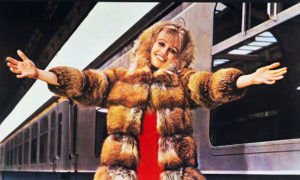In just over a month, “the world’s most famous locomotive” celebrates its 100th birthday. Flying Scotsman emerged — or was “outshopped”, as the railway people say — from the huge railway works at Doncaster on February 24th 1923. To celebrate its centenary, it will take a triumphal tour of the nation. The engine will not, however, be visiting its birthplace.
True enough, it is as hard to associate Doncaster with the continuing glamour of Flying Scotsman as it is to believe that Diana Rigg — svelte star of The Avengers — came from there. Michael Parkinson said Rigg “radiated a lustrous beauty”; the same cannot be said of modern-day Doncaster, so close to prosperous and pretty York, one stop north on the East Coast Main Line. When it comes to the North-South divide, the latter, cosseted by tourism, doesn’t really have a dog in the fight, whereas Doncaster seems emblematic of all that has gone wrong in recent decades.
The Flying Scotsman symbolises happier times for Doncaster. It owes its existence to what a recent Doncaster Council document described as “the most significant example of levelling up in Doncaster’s history”. In 1849, the town’s Tory MP, Edmund Beckett Denison, persuaded the Great Northern Railway to extend its line north to Doncaster, and to move its works there. By the turn of the century, those works — known as “the Plant” — occupied 200 acres and involved 60 miles of sidings, some tangled with the mineral lines serving nearby pits. The GNR was not exactly philanthropic, as Rowntree’s in York was, but it did reach out to the town. It built two schools for its workers. It helped pay for the construction of Station Road, a handsome thoroughfare along which arrivals by train might saunter into town, past the Oriental Chambers and the Grand Theatre.
In those days, London needed the North. Coal trains left Doncaster hourly for the capital. And the town was a destination, not just a resource. Tourists came for the races, and ambitious young men came from all over Britain to take up apprenticeships at the Plant, including W.O. Bentley, who would use the skills he learnt building fast trains to build fast cars. In 1911, a large, intimidating Scottish aristocrat called Nigel Gresley arrived at Doncaster as Chief Mechanical Engineer of the Great Northern. He designed the star product a new class of unprecedentedly big express passenger locomotives, built to haul heavy, luxury trains at speed along the East Coast Main Line. It was named Flying Scotsman.
The engine is often described as symbolising all that was best in British engineering, but it also represented an early flowering of the nation’s Public Relations industry, becoming a pin-up in many beautiful posters. There would be Flying Scotsman paperweights, jigsaws, ash trays. The loco regularly hauled the train named The Flying Scotsman between London and Edinburgh, and anyone who turned up to find a different engine at the front would feel short-changed, as when an understudy takes the star’s part in a play. The Flying Scotsman had luxury carriages, including the Louis XIV-style first-class restaurant car, a cinema carriage and a barber’s shop, in which shaves with a cutthroat razor were offered and accepted — a tribute to the train’s smooth riding. All these trappings were created in the Plant.
Why all this manufactured glamour? Mainly because of competition for the lucrative London-Scotland rail market, but also because of automobile competition. In the Thirties, people would be unlikely to drive from London to Scotland, but they might take a charabanc from York to Scarborough, and the LNER hoped its mainline publicity would add lustre to its local services, for which it adopted the tell-tale slogan, “It’s Quicker by Rail”.
While they were nationalised, in the second half of the 20th century, our railways were increasingly menaced by the rise of the automobile. Investment would be followed by retrenchment, indulgence by hangover, and in 1958 British Railways fell into the hands of a Transport Secretary succinctly described by Christian Wolmar, in his history of BR, as “a car man”. Ernest (‘Ernie’) Marples drove a Jag. He co-owned a company that built roads. He appointed Dr Richard Beeching, a physicist, to take a “scientific” approach to BR, which, not very surprisingly, turned out to mean cutting the network by a third.
Diesel and electric locomotives would be outshopped from Doncaster over the next 30 years, but trains had lost their primacy. The propaganda surrounding the Beeching cuts characterised railways as a second-class mode. They lost their sheen and so, therefore, did Doncaster. Marples was a Conservative, but Labour was half-hearted in opposition to his policies. In the late Sixties and early Seventies, Doncaster’s Labour Council capitulated to the motor car, just as similarly-hued councils did in Leeds, Sheffield and Bradford. If you emerge from Doncaster station today, you see an artwork celebrating the town’s locomotive-building history, but all you can hear is the traffic of the town’s inner ring road, constructed in 1970, which creates a barrier between the station and the town.
Doncaster, like most Northern towns, is uglier than it used to be. Elegant Station Road was obliterated by the construction of a huge shopping centre with five levels of parking above it. The only survivor is the Grand Theatre, which stands derelict opposite the station, a great white haunted house. Along the pedestrianised High Street, formerly the Great North Road, attractive premises that once housed grand banks and coaching inns are occupied by fast-food outlets, charity shops, barbers’ shops offering “Haircut £6”. In Doncaster’s most beautiful building, the Minster, I spoke to a local man in his eighties.
“There aren’t more than a couple of really good shops left on the High Street. Fifty years ago, they were all good, and you had some railway first class menswear shops and tailors.” (He was very well-dressed.) When asked how long times had been hard, he said: “I’d date it back to the pit closures.”
Unlike many other places that started to lose their mines in the late Eighties, Doncaster had railways to fall back on. But it suffered a more complete loss of machismo after it made its last loco in 1987. Today, the town retains what the council calls its “diverse railway cluster”, which employs 7000 people, 2000 more than the old Plant. But whereas everyone knew what went on in the Plant, the cluster is mysterious. No one person seems to have the complete list of its tenants. There’s the iPort, for example: an “intermodal rail terminal” signified by a mass of containers visible a couple of miles south of Doncaster on your right from northbound trains. Some containers are brought from abroad including, it is rumoured, by a train that comes via the Chunnel from China. Near the iPort are giant, blank-faced warehouses: Amazon distribution hubs. Doncaster has the dubious honour of being the only place in the UK to have three of these. A woman who works in a Doncaster café said to me: “Today, Donny is a distribution hub — don’t ask me what’s being distributed.”
Admittedly, there is a good deal of railway-related activity within the cluster. But this being modern “British industry”, many of the names are foreign. Wabtec Rail, an American-owned firm, refurbishes rolling stock at Doncaster. And there’s Volker Rail, a Dutch railway infrastructure company. The foreignness of the cluster is typical: of the 30 or so train operators in Britain today, only half a dozen have British owners. Professor Paul Salveson, a railway expert, says the Doncaster scene exemplifies “the willingness of British governments over the last fifty years to relinquish engineering — the idea that we don’t need to make things”.
Was this an ingredient in the overwhelming support for Brexit? All the towns in Yorkshire except the three most prosperous — York, Leeds, Harrogate — voted to leave the European Union, Doncaster by 69%. In a pub in the city centre, a local explained that people supported Brexit “because they thought something might change”. When asked what had changed, he said: “Nowt.”
But Doncaster’s economy was actually growing faster than the regional average pre-pandemic. Construction — some undertaken on the territory of the Plant — played a part: Doncaster is being regenerated. And it remains an important railway centre, both for passengers — six lines radiate from the town — and the industry. But the glamour is gone. As for the Scotsman, it pursues its whimsical afterlife. Having been saved from scrapping in 1962, it was owned by a succession of rail enthusiast-millionaires — two of whom it bankrupted. They ran it all over Britain until 2004, when it was acquired by the National Rail Museum — located, of course, in lucky old York.
In his book, Parallel Lines, Ian Marchant wrote that there are two railways in Britain: the railway of romance and the railway of reality. The latter, he added, was “largely shit”, and here might lie an opportunity for Doncaster. Our privatised railway is fragmented, with its separation of track and train operators, its multiplicity of ever-changing brands and liveries. Unlike The Flying Scotsman or the LNER, it is unknowable, and this is reflected in the anonymity of the Doncaster railway lands.
Great British Railways, the state-owned body expected to take over the nation’s industry, will supposedly fix this problem, providing a central “guiding mind”, and a more integrated network. What with the energy crisis and the recent political turmoil, the Bill to create GBR has been postponed. But the location of its headquarters is expected to be announced in 2023 even so. Doncaster made the shortlist — and it seems by far the most deserving candidate among Birmingham, Crewe, Derby, Newcastle and York.
There is no grand panacea for the sites of former industry. Steps to a better future will mostly be incremental. But occasionally there will be strides. Victory for Doncaster might top even the arrival of the Great Northern Railway as an instance of real levelling up. The city would unequivocally be a railway place once again — an even better thing to be in 2023 than in 1923, perhaps, given the newly recognised environmental kudos of rail. Skilled workers would flock there once more. There would also be intangible benefits: restored pride, an escape from the melancholic retrospection. And perhaps the starry locomotive will have assisted. Doncaster’s pitch for the role contained a killer line: “We built Flying Scotsman”.
Disclaimer
Some of the posts we share are controversial and we do not necessarily agree with them in the whole extend. Sometimes we agree with the content or part of it but we do not agree with the narration or language. Nevertheless we find them somehow interesting, valuable and/or informative or we share them, because we strongly believe in freedom of speech, free press and journalism. We strongly encourage you to have a critical approach to all the content, do your own research and analysis to build your own opinion.
We would be glad to have your feedback.
Source: UnHerd Read the original article here: https://unherd.com/




